This is the fifth of six articles devoted to an exhibition at the Museum Tinguely in Basel, Switzerland of works by Vladimir Tatlin (1885-1953), one of the most important artists of the Russian and Soviet avant-garde. Part 1 was posted June 19; Part 2, June 20; Part 3, June 21; Part 4, June 25.
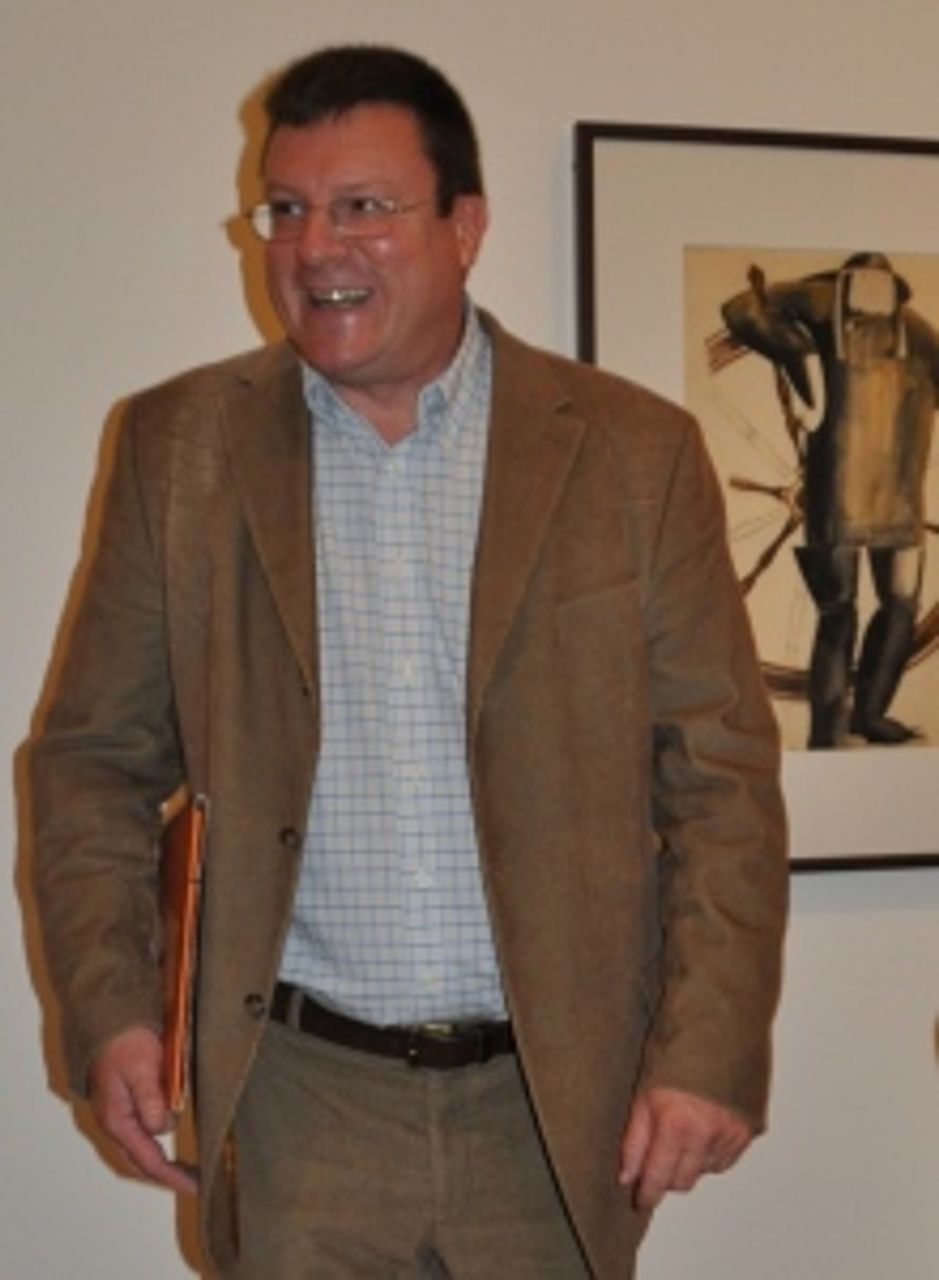 Dr. Gian Casper Bott in front of the image
Dr. Gian Casper Bott in front of the imageVladimir Tatlin, mate. Stage design
Wagner’s opera “The Flying Dutchman”
1915-1918, National Central
A.-A.-Bakhruschin Theatre Museum, Moscow
The day after the opening of the Vladimir Tatlin exhibition at the Museum Tinguely in Basel, two reporters for the World Socialist Web Site spoke with Dr. Gian Casper Bott, the curator of the exhibition. Dr. Bott played a major role in ensuring that the exhibition offered a comprehensive look at the work of this leading figure of the Russian and Soviet avant-garde.
WSWS: What prompted you to mount this exhibition? What gave you the idea for it?
Gian Casper Bott: The idea came from Roland Wetzel, director of the Museum Tinguely. He has a particular fondness for the Russian avant-garde; not least, because it’s a subject the museum specialises in.
We know each other from our mutual work at the Basel Kunstmuseum, whose entire collection was the subject of a book I wrote.
So the idea for the Vladimir Tatlin exhibition came from Mr. Wetzel. But as soon as he mentioned it, I was hooked. I very quickly realised it would be a really big challenge. It’s a wonderful challenge, because it’s such a complex undertaking.
First, I tried to figure out where Tatlin’s pictures might be found. The names of most of the galleries and institutions in Russia have been abbreviated and these abbreviations have changed over time. So, first of all, that had to be sorted out.
The key to doing that was certainly the catalogue of the Tatlin exhibitions in Germany and Russia in 1993-94, which is actually a catalogue raisonné [giving the entire work of an artist]. In many cases, one had to read through a lot of text, or accept that this or that item was “lost”. The question was: what is there to find at all?
In 2010, we made our first finds and, by early 2011, we’d developed a concept. We decided to exhibit Tatlin’s works as those of a revolutionary: revolutionary, first as an artist or a member of the avant-garde, and then as a politically and historically revolutionary figure.
That also meant that we had to leave out certain areas, or only hint at them. That, certainly, included Tatlin’s late paintings that were begun in the 1930s, after he had been restricted in his activity by the Stalinist regime. During this period, Tatlin withdraws into himself—or does he? This is still an open question. He starts to paint again. But he is one of the very few artists prepared to defend his art and works publicly.
He takes up his work for the theatre again, even more intensely than ever. There he finds a kind of artistic niche where he can still do something. Tatlin involved himself in theatrical work his whole life long. But it’s clear that he isn’t satisfied or happy with it. He says there aren’t enough projects on offer.
His late paintings can appear rather “tame” at first glance, and some people see them as oddly devoid of meaning. Actually, they are very poetic and convey an extremely strong sense of the materiality of painting. He develops idiosyncratic nuances of colour, and his technique is really very special too. Sometimes you have the feeling you are looking at one of his fingerprints or a hair in the paint. Sometimes he engraves the colour with the wrong end of the brush, or he eases it on like watercolours. In fact, he’s continuing the repertoire of his earlier works.
However, it’s clearly being done in a different time. It would certainly be interesting to make Tatlin’s late paintings the subject of an exhibition, but the Tinguely Museum would be the wrong place for it.
Tatlin’s work as a designer, his work for so-called everyday culture, his designs for clothes and household items are also only hinted at in this exhibition. We deliberately wanted to focus on Tatlin’s revolutionary art. At the present historical moment, our concern is to show the revolutionary role played by Tatlin and his really great strengths.
The early paintings—ten of Tatlin’s pictures, all from the years 1911 to 1913, hang in the large first room—comprise virtually all Tatlin’s artistic work up to the Revolution. Almost everything is included. We really wanted to give a complete account of this period.
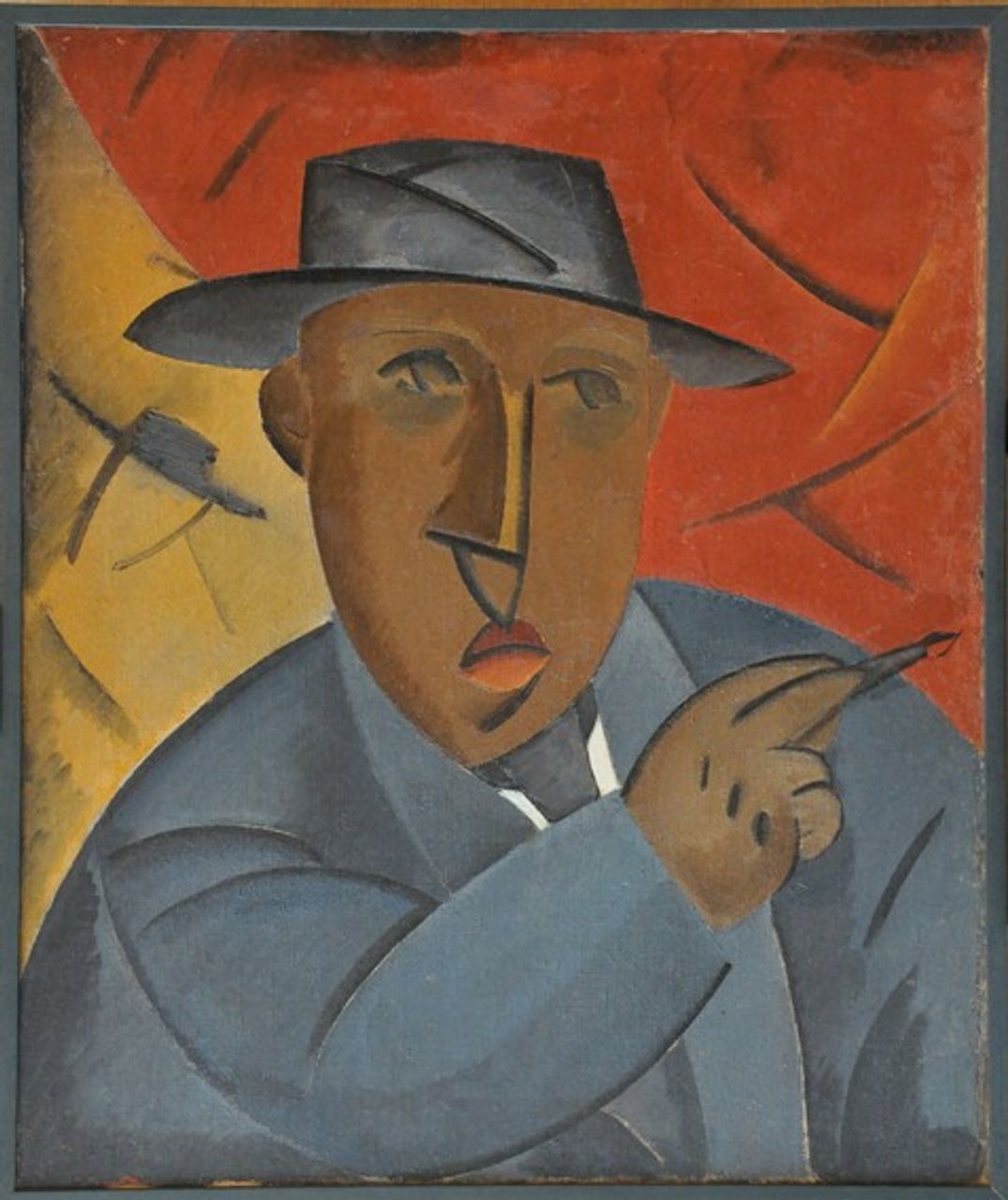 Vladimir Tatlin, Portrait of a painter (Self-Portrait), 1912. Copyright: photo 2012, Museum of History, Architecture and Fine Arts, Kostroma
Vladimir Tatlin, Portrait of a painter (Self-Portrait), 1912. Copyright: photo 2012, Museum of History, Architecture and Fine Arts, KostromaIt includes the marvellous portrait of a painter, Tatlin’s self-portrait. It’s almost an icon: he holds the brush almost like a gesture of blessing. It comes from the Museum of History, Architecture and Fine Arts in Kostroma [215 miles northeast of Moscow].
We’re extremely lucky to be able to exhibit it here; it’s a wonderful picture—the quiet retention of colour and, simultaneously, the powerful force and momentum of the contours.
Tatlin and Malevich
WSWS: Vladimir Tatlin and Kazimir Malevich were very different artists and their views are often highly controversial. But they had similar backgrounds, both suffered from Stalin’s attempt to thwart them, and both refused to capitulate. Neither associated himself with “socialist realism”. Do you see any evidence of what enabled these artists to resist capitulation?
GCB: Both artists appear to be antagonists in the great, history-making avant-garde exhibition in Petrograd in 1915 … Malevich wants to hang his famous “Black Square” in the usual place for icons, Tatlin exhibits his counter-reliefs for the first time.
But their antagonism has surely to be seen in relation to their styles. It is a period when two or three days could decide who did what first.
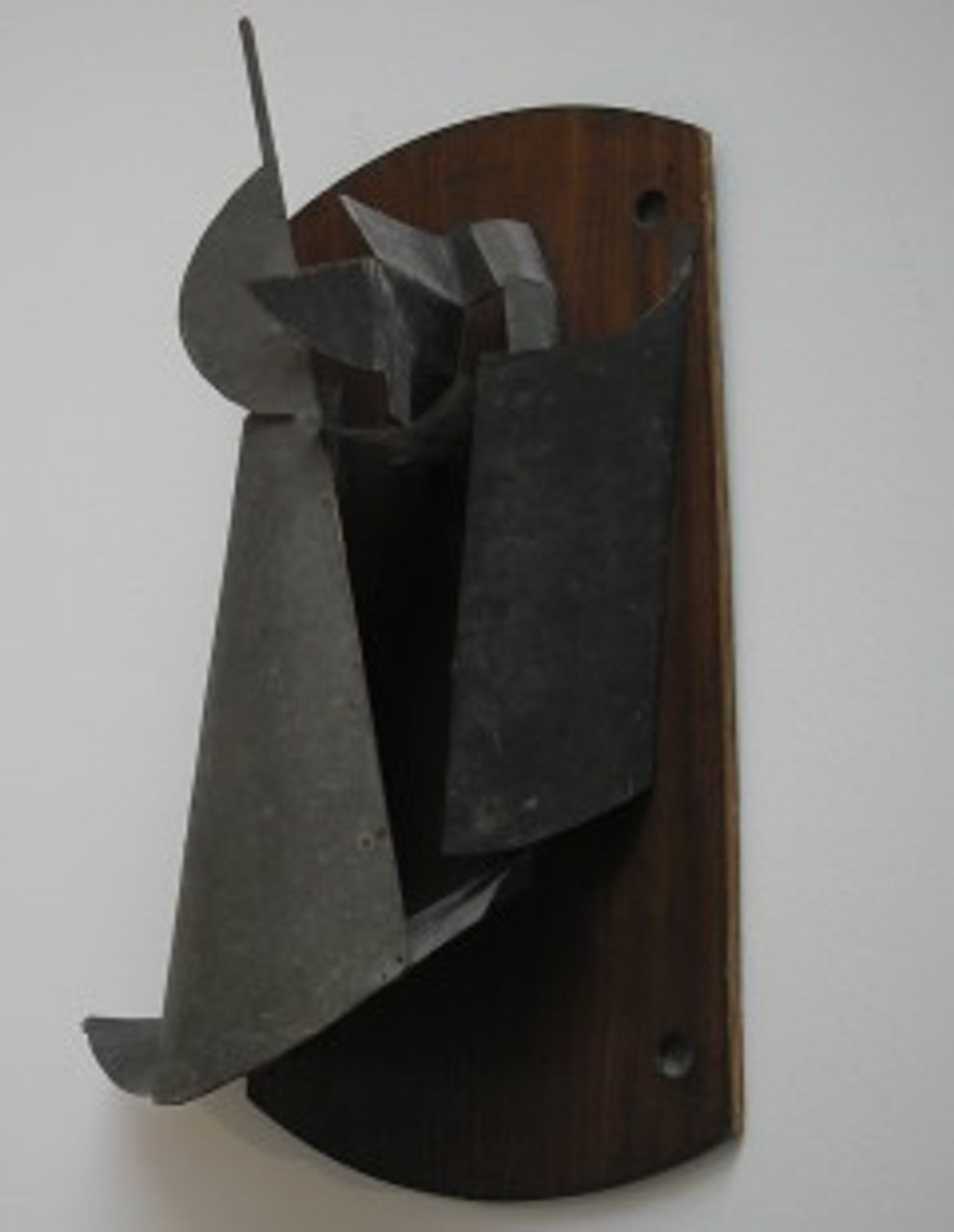 Vladimir Tatlin,
Vladimir Tatlin,Counter-relief (material selection), 1916,
State Tretyakov Gallery, Moscow,
photo WSWS
There’s a story that Tatlin stuck newspaper over his studio window in case Malevich, who had a studio nearby, sought to steal his ideas. Or there’s the anecdote, which perhaps is true, that Tatlin brought his counter-reliefs to the exhibition and mounted them at the very last moment because he was afraid a colleague—presumably Malevich—might steal one of his ideas.
I suspect—although I can’t prove it—that they were, in fact, on quite friendly terms. They were aware they were the mainstay of this whole movement.
As for the scourge of Stalinism, I can’t imagine Tatlin ever succumbing. He was simply far too convinced of the ideals of the revolution. I’m no historian, but I thought it necessary to include in the catalogue a text explaining Tatlin as a political being. That was the text provided by David Walsh of the WSWS.
I’d long been looking for someone qualified to do this. Then I came across Walsh’s review of the Guggenheim Museum’s exhibition, “The Great Utopia” in 1992 [1]. He obviously has a profound understanding of his subject and he discusses it appropriately. It was clear we were going to need an historian or political scientist for this task.
At the 1993 Dusseldorf exhibition, Tatlin’s work was perhaps presented in a way that distanced it too much from the political scene, although at the time—shortly after the dissolution of the Soviet Union—probably nothing else was to be expected. But Tatlin himself said he was the first artist to have greeted the Bolsheviks immediately after the revolution.
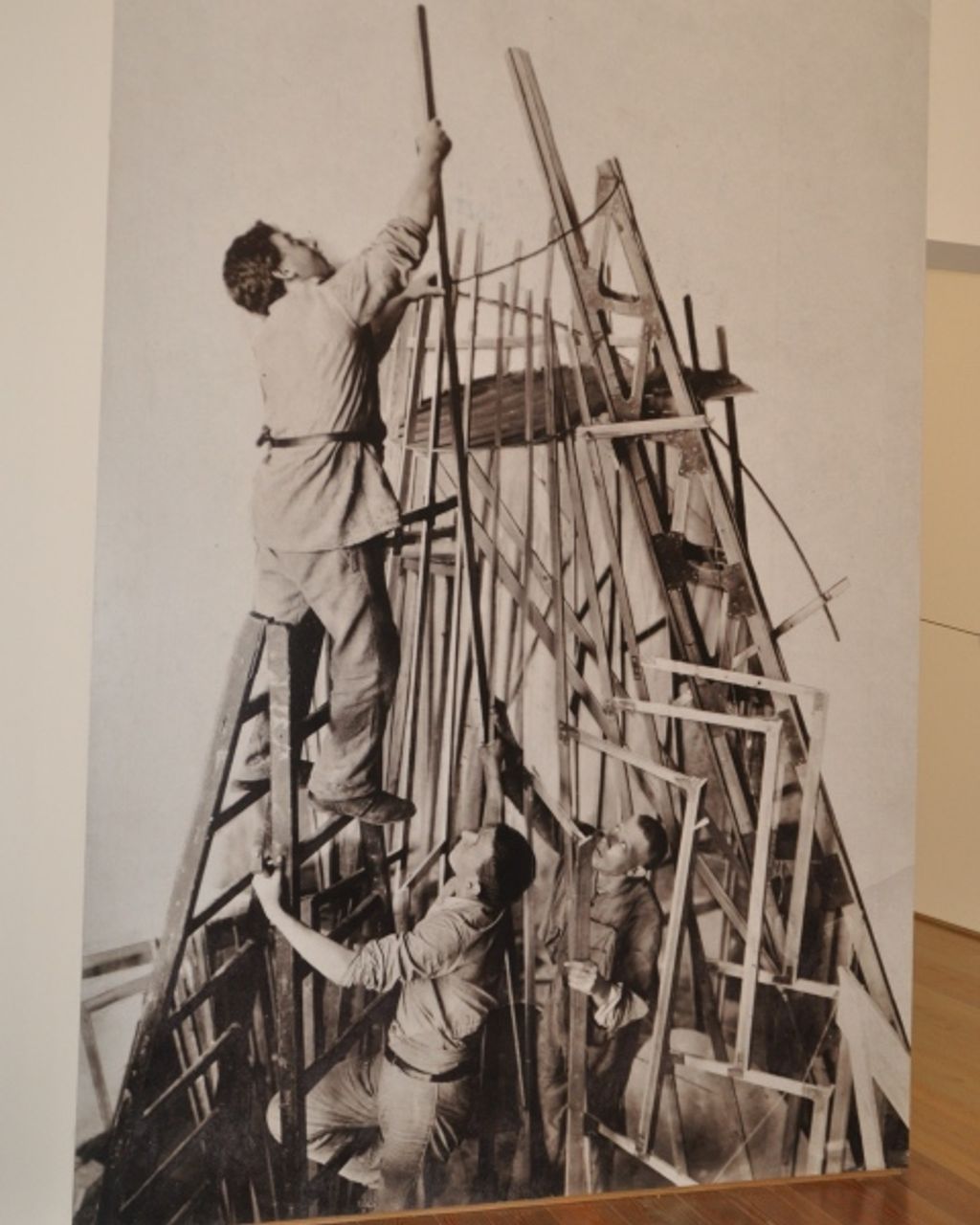 Historical photo of documentation of the exhibition: Tatlin with helpers at the Tower, Petrograd, 1920, unknown photographer
Historical photo of documentation of the exhibition: Tatlin with helpers at the Tower, Petrograd, 1920, unknown photographerHis tower is quite obviously—but not only—an agitation-propaganda machine. It is also a great piece of sculpture, beautifully architectured and pointing the way to the future. But some of its features are pure propaganda. Motorcycles loaded with agitational texts and loudspeakers stream out of garages into the city, to rouse citizens to action, and there are searchlights projecting huge political slogans onto the cloudy night skies.
At the beginning, the Russian Revolution was a great utopia, inspiring people whose aim was to improve the whole of humanity. It was all about creating a just world in which art would play a completely new role; a world that would have been unthinkable without the art. Art was a very important part of the Revolution.
Stalinism—a counter-revolution
David Walsh’s text made me realise this (previously I hadn’t really grasped it): that Stalinism was a counter-revolution, in which the bureaucracy paralysed everything progressive.
This is what we witness in the fate of Nicolai Punin. Punin, a co-fighter of Tatlin, wrote the agitational piece, “The Monument to the Third International”, in 1920. He published the first biography of Tatlin, “Against Cubism”, in Petrograd in 1921. Punin eventually perished in a Siberian prison camp.
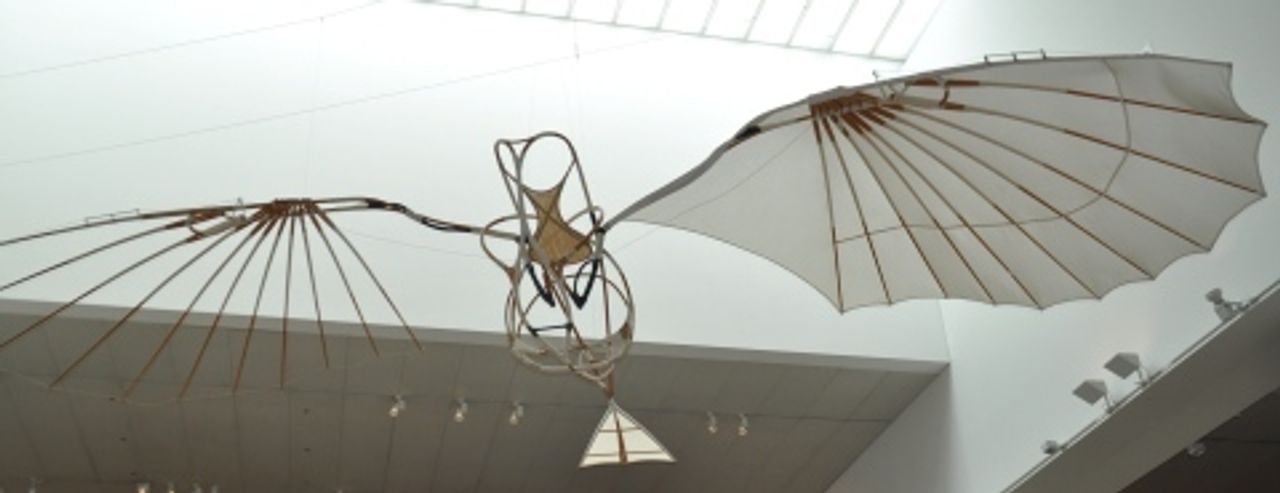 Vladimir Tatlin, Letatlin [1929-32], reconstruction of Jürgen Steger, 1991, Zeppelin Museum Friedrichshafen
Vladimir Tatlin, Letatlin [1929-32], reconstruction of Jürgen Steger, 1991, Zeppelin Museum FriedrichshafenThe question can be raised: why was Tatlin spared such a fate? It’s possible he was no longer taken quite so seriously in the 1930s. At the end of his revolutionary career, there was that “Letatlin” [one-person flying apparatus] he created, and one could quite simply say: “He’s crazy anyway”. Maybe that was the reason why he survived.
What I still don’t quite understand is why Tatlin was able to remain so close to the centre of power in the years 1919 and 1920. Vladimir Lenin attends an exhibition of Tatlin’s tower. Anatoly Lunacharsky, the commissar for education, forwards a letter from Tatlin to Lenin, and may have read it himself.
The tower is initially titled the Monument to the October Revolution, but is very quickly renamed the Monument to the Third International. But maybe it was too modern or too abstract for Lenin.
WSWS: Could it have been that Lenin’s criticism was similar to that of Trotsky, as expressed in Literature and Revolution?
GCB: Trotsky undertakes a very sympathetic criticism. Concerning the rotating buildings inside the tower, he writes that one might question why the seat of world government really has to turn. Leaving this question more or less floating in the air, he then says: it seems to give me the impression of still-standing scaffolding. But that is certainly not meant as barbed or disparaging criticism; rather, it conveys an awareness of a poetic element in the work.
However, Lunacharsky said it might have caused bitterness among the city’s [Petrograd’s] citizens if it really was built. He said he didn’t like the idea of “our cities (being) filled with such US-looking Tatlin towers”.
At the time, a remarkable number of very prominent personalities in Russia commented on Tatlin’s tower. Ilya Ehrenburg said (in his memoirs) it occurred to him that this tower had allowed him to peek through a crack in the door of the twenty-first century. But one senses this great optimism was expressed at a time when the conditions were far from rosy.
I wonder if there ever really was an idea of actually building Tatlin’s tower. It would have been in line with Tatlin’s artistic sensibility to conceive of the tower—in the broadest sense—as a theatrical act. Had the tower been built, it might have lost some of its utopian, visionary character. The question is also: would it still be standing today, anyway? Probably not. It would probably have been demolished in the 1950s, if not the 1930s.
WSWS: That happened to a large section of avant-garde architecture, as the current Berlin exhibition, “Building the Revolution”, so effectively shows.
GCB: Yes, exactly.
In any case the theatrical element plays a major part in Tatlin’s work. It is already evident in the portrait photographs of the artist himself. He arranged the photography extremely carefully. Although he was the person photographed and not the photographer, he certainly gave instructions about how the photos were to be taken.
For example, the setting for the early photo from 1916, which also appears in Punin`s pamphlet, is very carefully composed. Decades later, we then have another photo, in which he presents himself in exactly the same way. Then there is a postcard presenting him as a sailor resembling his 1911 self-portrait. It can’t be a coincidence. He most certainly was inclined to gesture in a way that said: “Look here, this is the way it is”.
It might be the same sort of thing with his tower. There he’s saying: it will be 400 metres high, it will be so and so—knowing full well it would be extremely difficult to accomplish, at least at that time. One senses the same theatrics in his Letatlin, when he actually knows, of course, that it certainly can’t function. But he claims (in a positive, visionary sense): this will function.
Letatlin—looking for the ideal form for a vision or a dream of humanity
It is necessary to find the ideal form for an artistic work, a vision or dream of humanity. The rest will then fall into place. Regarding Letatlin, I imagine Tatlin said to himself: it’s like in music. We’ve found the ideal form for the violin, and now we just have to practise on it from childhood to be able to play it wonderfully. Or it’s like cycling: the form of a bicycle can hardly be bettered. If you’ve learned it as a child, you can actually ride a bicycle.
Tatlin doesn’t begin with calculations; he conceptionalises a form he believes to be so perfect that it would simply have to function properly. He considers his result [Letatlin] an ideal form, replete with elegance and beauty, and places it in 1932 in the Italian room of today’s Pushkin Museum, where there also stands a large copy of Michelangelo’s “David”. One has the impression he’d say: “Look, that is the old art (which he certainly appreciates!); and my Letatlin, this is the new art.” So it seems to me.
Then there’s also the idea of a reference to the Renaissance. “David” embodied ideal Renaissance man.
And—even more so for the tower—the form recognisably reflected human proportions. It has an anthropomorphic component. The turning body could be regarded as the head. Punin said something along the same lines: “We do not yet know how to present the new man”. It is quite clear that one can no longer present him on horseback or as the “David”. Instead, he surely has to be presented via elementary forms, like those of the new art.
WSWS: What do you make of Tatlin’s statement that “the eye must be controlled by the sense of touch”: Is he concerned with a rehabilitation of the sense of touch in art, a transition from two-dimensional painting to three-dimensional art, or also with the creation of a feeling for the materials?
GCB: Tatlin says he has appealed to his colleagues since 1912 “to control the eye with the sense of touch”. On the one hand, this is a call to certify for himself a new or different kind of realism. The motif of touch as key to belief is found in the Bible with Saint Thomas the apostle, who has to put his finger in Christ’s wound in order to believe what he sees.
There is another issue, associated with the competition among the arts since the Renaissance: which has precedence, sculpture or painting? Sculptors say sculpture has the advantage of being able to be touched, but Leonardo da Vinci says that this, of course, is not an advantage of art, but of nature. A piece of wood inherently has this quality, and art is concerned with simulating it. In the seventeenth century, however, Galileo nicely gets to the heart of the matter when he says: sculpture, and not only painting, is a matter of simulation. Sculpture simulates characteristics such as softness, hardness, coldness and all the sensory properties.
Tatlin’s general knowledge of such things should never be underestimated; he could well have known all about this. He does not say: “We should subordinate the eye to the sense of touch”. Nowhere does he say such a thing.
The episode concerning Tatlin as the bandura [Ukrainian lute] player is important for understanding his emphasis on the sense of touch. We had a bandura player here from the Ukraine, Sergei Zakharets, who appeared at the opening. He told me he had constructed his own bandura. And Tatlin did the same thing.
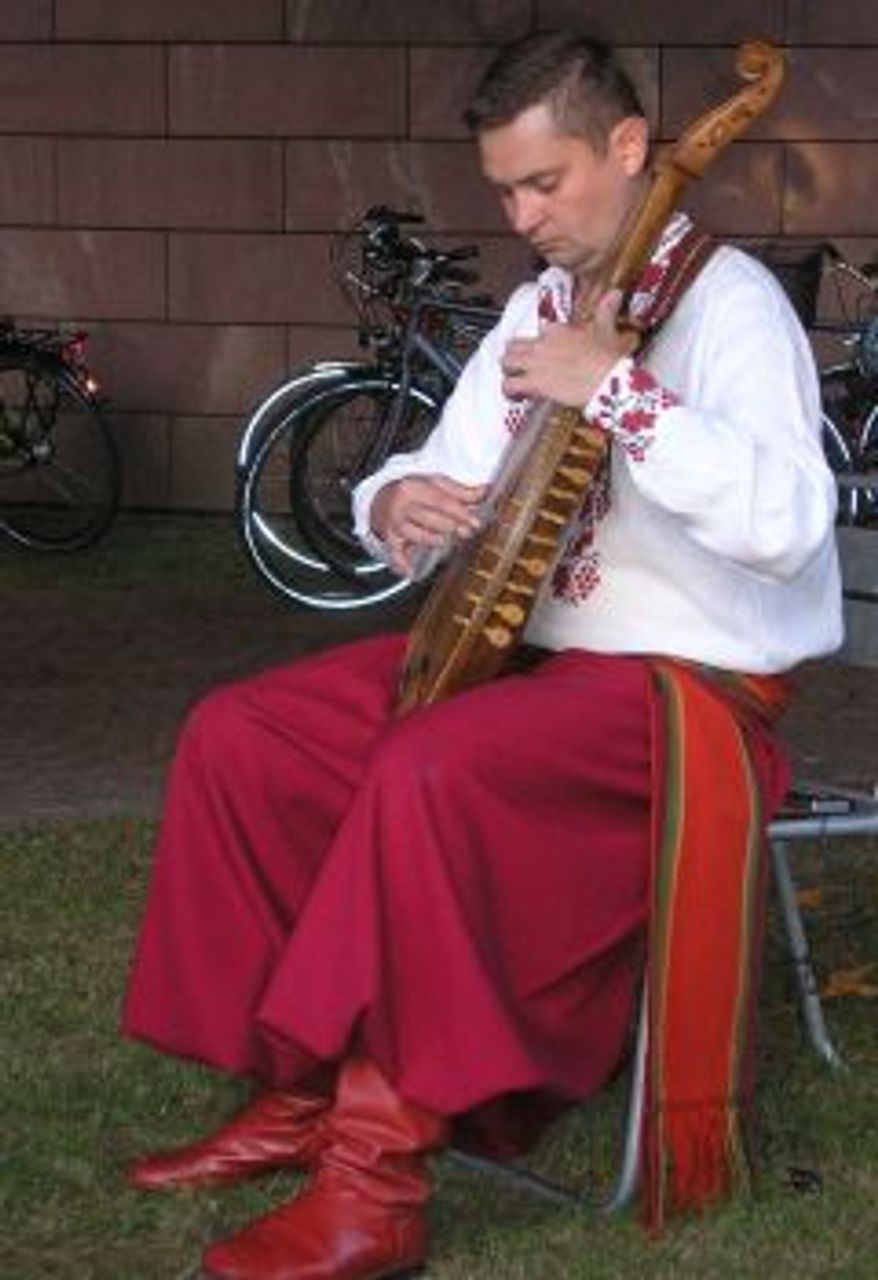 Sergei Zakharets,
Sergei Zakharets,Bandura player at the opening
in Basel, photo WSWS
Tatlin presents himself to the world as a blind bandura player. This role is meant not only to dramatically symbolise artistic inspiration (which it certainly also does! Homer the blind poet, etc.). Sergei told me that such bandura players actually were blind and this was how they earned their living. And they were usually accompanied by a boy, leading them, and these boys also learned how to play by watching the blind players. The bandura really is played by attending to the sense of touch. So the saying about controlling the eye with the sense of touch takes on another meaning, and each meaning merges into the other.
Tatlin has left us only a few pithy statements, for example, “Neither new nor old, but what is necessary”. What is striking about both the tower and the Letatlin, but also his counter-reliefs, is that Tatlin creates something completely new, while simultaneously rooting the whole thing deeply in tradition. He draws on Leonardo and develops a vision that is focused entirely on the future.
”I am an artist, I provide ideas”
WSWS: As far as the advocates of Proletarian Culture were concerned, independent art was firmly repudiated; art was supposed to serve only propaganda purposes. Didn’t Tatlin manifestly reject this line?
GCB: Yes, he rejected it, and this can be seen in his work. He is not someone who comments on that: he is actually very tight-lipped. In the 1920s, the dominant tendency is “bringing art into the everyday world”, but Tatlin never sees art as a handmaiden to politics; instead, art plays an independent role for him.
Maria Lipatova headed her catalogue essay with Tatlin’s wonderful saying: “I am an artist, I provide ideas”. That is very appropriate. He saw his task to be the invention of ideas, and it was the business of other people, engineers and professionals, to figure out how to use or realise them. But not vice versa, and that was very important for him.
That’s why I don’t particularly like using the term “design” in relation to Tatlin. He’s not concerned with providing a product with a pretty shape. Tatlin develops the most beautiful and most appropriate form for a special purpose.
WSWS: Didn’t he also work with others in the Soviet artistic milieu in a highly interdisciplinary way?
GCB: Certainly. And that is most apparent during the development of the Letatlin.
In this respect, his work shortly after the Revolution is also important. Tatlin concerns himself with how to revolutionise the training of artists and the role of museums. He thinks about a museum of contemporary art, and does so decades before the same thing becomes an issue in New York. This demonstrates his revolutionary approach, too.
It is striking that he doesn’t produce a single counter-relief after the Revolution. He probably saw it as primarily an artistic problem—one that could be solved brilliantly. But the Revolution has set artists a new task, and given art another dimension. He only uses counter-reliefs as an artistic exercise for his students.
Concerning his counter-reliefs, probably only three or at most four original works survive. And the two most important are on show in this exhibition: the 1914 “Corner counter-relief” from the Russian Museum and the 1916 “Material Selection” from the Tretyakov Gallery. These are definitely “sacred cows”, similar to Malevich’s “Black Square”.
Colleagues previously told me there was no chance of getting them; they’d never be lent out. And now they’re hanging here side by side. It was wonderful to see how the couriers who delivered the two art works were touched to see them both together.
The exhibition offers a really surprising number of originals. We’ve got practically all of the surviving early paintings, and the same goes for the counter-reliefs. And we have the two most interesting tower reconstructions from the Longépé studio at the Pompidou Centre in Paris and from Dmitrii Dimakov in the Tretyakov Gallery.
What particularly fascinates me is that being able to compare them allows one to see into them more deeply. Many features only become apparent when the quality of one is compared with the other. The Russian reconstruction conveys perhaps more sharply a sense of how Tatlin had to make do with the available materials.
It’s also striking that Tatlin never painted pictures with the intention of selling them. Markets did not exist as far as Tatlin was concerned. I know of no other artist who was so totally uninterested in the art trade as he was. Even his earliest paintings are clearly produced to be exhibited and to promote his art, but not to be put on sale. The idea simply didn’t cross his mind.
In his painting as exemplified in our exhibition’s ten superb pictures of his early phase, he virtually races from one stage of development to the next, and each stage is characterised by works of such a momentous artistic potential that, as other artists certainly did, the ideas could be exploited for two or three years.
To be continued
Note:
[1] David Walsh: Bolshevism and the avant-garde artists (1993), World Socialist Web Site [17 February 2010]
